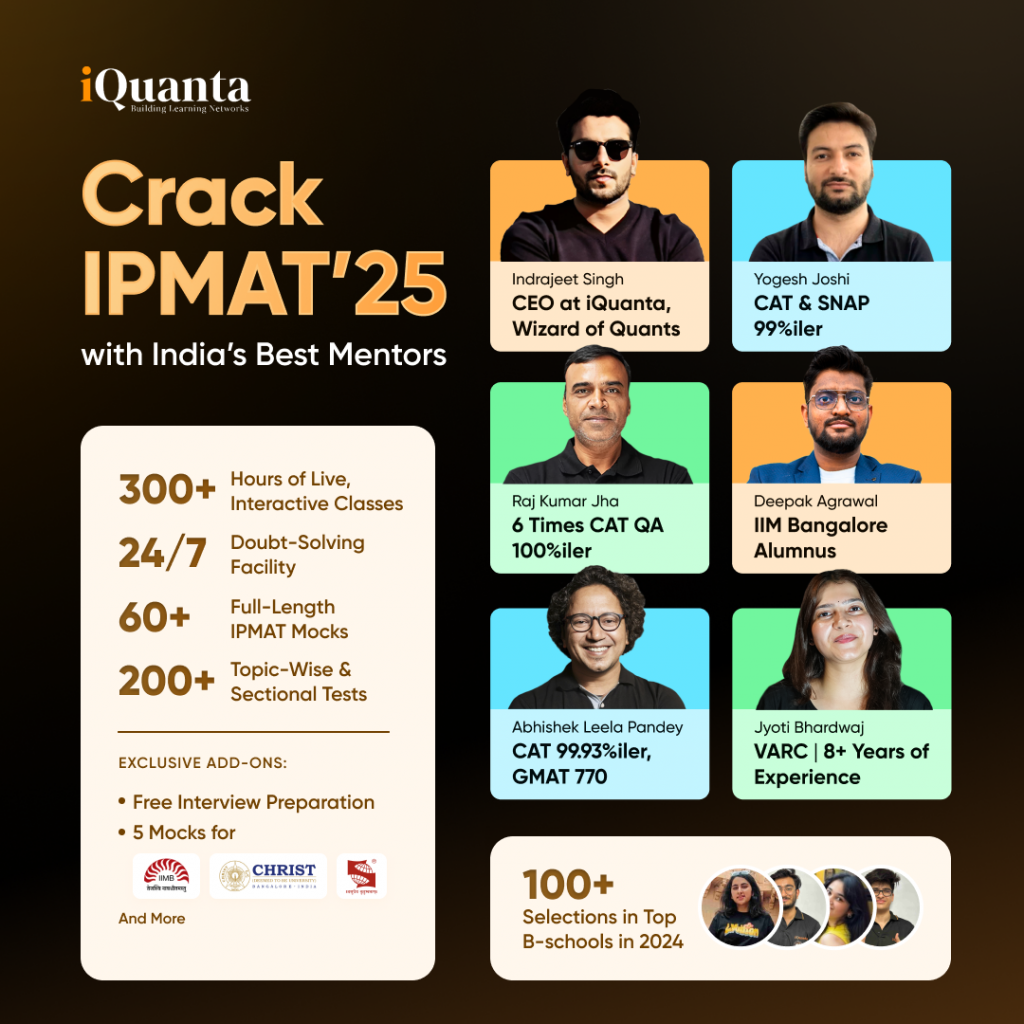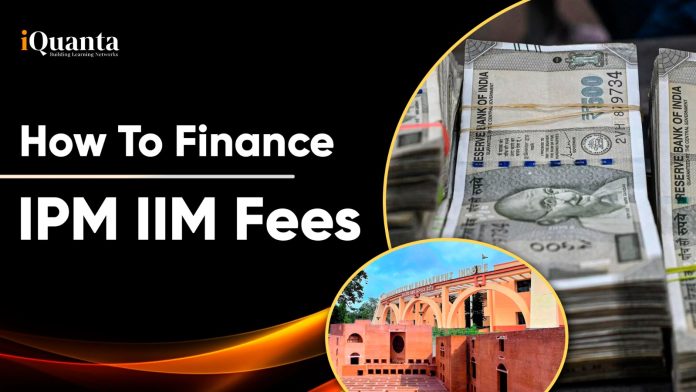Pursuing an Integrated Program in Management (IPM) at one of India’s prestigious Indian Institutes of Management (IIMs) is a dream for many. The five-year IPM program, offering a combination of undergraduate and postgraduate management education, is a great experience and an investment in your future.

However, like any top-tier education, the financial commitment can be significant. The fees for an IPM program at IIMs can vary, but students can expect to pay between ₹16 lakh to ₹25 lakh over the five years. This includes tuition, accommodation, living costs, and other incidentals like books and study materials. In this blog, we’ll explore how you can manage the cost of IPM IIM fees, from scholarships and government assistance to loans and financial planning.
Scholarship Terms Offered by Various IPM Colleges
Many IIMs, including those offering IPM programs, offer scholarships to ease the financial load. These scholarships can be merit-based, need-based, or both
- Need-Based Scholarships: These scholarships are awarded based on the financial status of the student or their family. They aim to provide financial support to students from economically weaker sections. IIM Indore offers several need-based scholarships for IPM students, where the amount varies based on the family income
- Merit-Based Scholarships: If you have strong academic credentials, many IIMs offer merit-based scholarships. These are usually given to students who excel academically during their course. IIM Rohtak offers merit-based financial aid to its IPM students, significantly reducing the overall tuition burden
| Institute | Type | Eligibility | Amount |
| IIM Indore | Need-based and Merit-based | Based on academic performance and financial need | Varies, typically a percentage of fees |
| IIM Rohtak | Merit-based | Top-performing students in academics | ₹1 lakh per year for merit students |
| IIM Jammu | Need-based and Merit-based | Based on financial status and academic performance | Up to 100% of the fees |
| IIM Bodh Gaya | Merit-based | Based on top ranks in the entrance exam | Full/Partial waiver of fees |
| IIM Ranchi | Need-based | Financially disadvantaged students | Varies, based on income |
Financing IPM Fees Via Government Assistance
The National Scholarship Portal (NSP) is a one-stop platform that offers various scholarships for students across India. For IPM students, this portal is especially useful for securing Post-Matric Scholarships if they come from financially disadvantaged backgrounds or Central Sector Scheme of Scholarship that provides funding for college and university students pursuing full-time courses, including those at IIMs.
By regularly checking the NSP, you can identify scholarships that apply to you and take advantage of financial assistance from the government.
Funding Your Education Through Education Loans
If scholarships don’t fully cover the cost, taking an education loan is a viable option. Several banks in India, like the State Bank of India (SBI) and Central Bank of India, offer educational loans, which are ideal options for IPM students.
- SBI Scholar Loan: The SBI Scholar Loan is one of the most popular educational loan schemes in India:
- Loan Amount: Covers up to ₹20 lakh, which is more than sufficient for an IPM course
- Interest Rate: Around 8.25%
- Collateral Requirement: No collateral required for loans up to ₹7.5 lakh. Higher amounts may require collateral or a third-party guarantee
- Moratorium Period: This is the grace period after course completion before you need to start repaying. Typically, this period lasts one year or until you get a job, whichever is earlier
- Repayment Period: The repayment period extends up to 15 years, allowing flexibility for students
- Central Bank of India Educational Loan: Another prominent option is the Central Bank of India education loan, which offers similar benefits:
- Loan Amount: Up to ₹20 lakh for education in India
- Interest Rate: Around 8.5% to 9%
- Collateral Requirement: Collateral may be required for loans exceeding ₹7.5 lakh
- Moratorium Period: Generally six months to one year after course completion
- Repayment Period: Up to 15 years
To further streamline the loan-taking process using the above options, the government has launched the Vidya Lakshmi Portal, designed to simplify the process of applying for educational loans. Through this portal, students can:
- Apply for loans from various nationalized banks and private lenders
- Track the status of their loan application
- Compare interest rates, repayment terms, and collateral requirements across different banks
By visiting the Vidya Lakshmi Portal, you gain access to a wide range of financial institutions offering educational loans, making the process quicker and more efficient.
Important Terms To Know Before Financing Your IPM Journey
When applying for an education loan, there are several important terms you should be familiar with. Understanding these terms will help you navigate the loan process smoothly and plan your finances accordingly.
- Quantum of Loan: This refers to the loan amount you are eligible for. The higher the amount, the more scrutiny you might face regarding collateral requirements
- Collateral: Some loans, especially for larger amounts, require you to pledge collateral. This could be property, fixed deposits, or other assets
- Repayment Period: The period over which you must repay the loan. Educational loans generally offer longer repayment periods (up to 15 years)
- Moratorium Period: A grace period after your course completion before loan repayments begin. This can range from six months to one year
- Interest Rate: The rate at which the bank charges you for the loan. This can vary depending on the bank and loan amount
Key Timelines to Finance IPM IIM Fees
- Admission Deadlines: Keep track of IPM program deadlines, as well as scholarship and loan application timelines
- Loan Processing Time: Loan approval and disbursement can take 15-30 days. Start your loan application process early to avoid delays
- Scholarship Application Deadlines: Many scholarships have deadlines at the start of the academic year. Make sure to apply for them well in advance
Documents Required to Finance Your IPM Fees
- Proof of Admission: A copy of your admission letter from the IIM
- Identity Proof: Passport, Aadhar card, or other government-issued IDs
- Address Proof: Utility bills, rental agreements, or a government-issued address proof
- Income Proof: Income tax returns or salary slips from your parents/guardians
- Academic Records: Transcripts from your high school or undergraduate degree
- Co-Applicant Details: If your parents are co-signing the loan, their details and financial documents will be required
Loans v/s Scholarships: Which one should you prefer?
When it comes to financing your IPM education, it’s essential to weigh the pros and cons of scholarships and education loans. Scholarships offer immediate financial relief and don’t require repayment, making them an excellent first step in reducing the financial burden. However, they are often limited in number and highly competitive, with strict eligibility criteria. On the other hand, loans provide greater flexibility in terms of the amount and accessibility, allowing a broader range of students to fund their education, but they come with the obligation of repayment, including interest. A smart approach can be to aim for scholarships to minimize your out-of-pocket expenses and use educational loans to fill any remaining financial gaps. This balanced strategy ensures you maximize available resources while keeping future debt manageable.
Financing your IPM education at an IIM doesn’t have to be an overwhelming task. With the right combination of scholarships, government assistance, and educational loans, you can make your dream of pursuing an IPM program a reality without compromising on quality education. Take advantage of all available financial resources, plan early, and choose the option that best fits your financial circumstances.
Still confused? Listen to our subject matter expert breaking down the various financing options available for you below, and don’t forget to check out various such informative videos as well as free preparation resources available on iQuanta’s YouTube channel:


